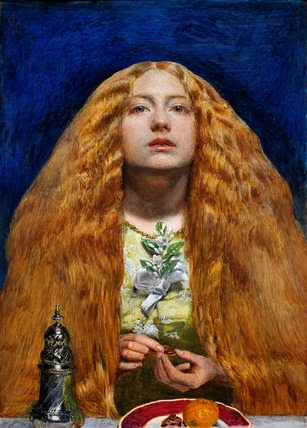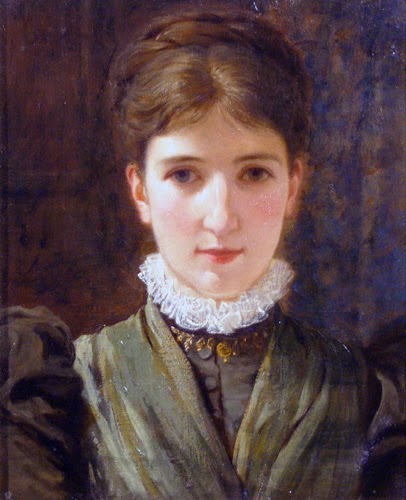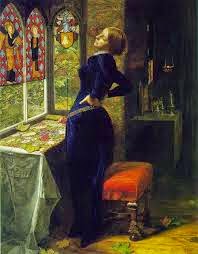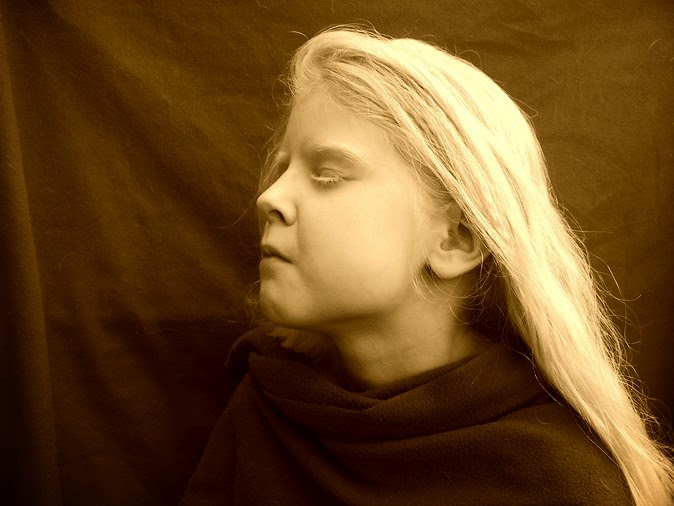There are few pictures in the Pre-Raphaelite art world that seem to elicit the same level of fervent passion as one by John Everett Millais. No, not this one...
Yes, yes, we all love
Ophelia, floaty lady, little robin, all that stuff. That wasn't the one I was talking about, because although we love
Ophelia I have rarely seen the level of reaction to it as to this gem...
 |
| Portrait of a Girl (1857) John Everett Millais |
My heavens, I have seen both men and women prostrate themselves in front of this beautiful picture. The challenging tilt of this 14 year old's chin seems to do funny things to people not just now but throughout this picture's history. Brace yourself, it's not a cheery history, but maybe that's the point. This is the story of Sophia Margaret Gray.
 |
Sophia, aged 11
by Millais |
Sophia Gray, more commonly known as Sophy, was the younger sister of Effie, wife of Ruskin and Millais. She hit a rather difficult age just as her sister was annulling one marriage and escaping to another, rather more happier one. She was staying with her sister in the Ruskin household in the last years of the marriage and was by her sister's side as she left her husband. Sophy was 11 years old at the time. Millais produced the portrait on the left for his beloved's parents, and Sophy acted as go-between for Millais and her sister, visiting the artist's studio to deliver messages and waiting patiently for replies.
Unfortunately for Sophy, she became a part of the mess her sister's marriage became, being pulled from one camp to another as the Ruskins and the Grays dismantled all goodwill and reason. The affect this must have had on the feelings of a child, a very intelligent child, can only be speculated about but is worth bearing in mind.
 |
| Autumn Leaves (1855-56) J E Millais |
When her sister finally married Millais, the couple settled close to the Gray home and Sophy was available to act as model for her brother-in-law. As a 13 year old girl, she appeared in the centre of the striking composition of
Autumn Leaves, casting the leaves onto the bonfire while the other girls look on but seem lost in thought. Sophy looks out at us and her gesture is ostentatious, marking symbolism in her action. The painting hints at the end of a day (it is painted at twilight), the end of a season and possibly the end of innocence, with overtones of the Garden of Eden. Sophy acts as the child making a sacrifice to end something. She looks at us in challenge, as an equal.
.JPG) |
| Apple Blossoms (Spring) (1856-9) J E Millais |
On a similar theme, Sophy is one of many teenaged girls on the cusp of womanhood. On the far left, arranging her hair, Sophie watches over the scene as her other sister, Alice, on the far right, looks out at the audience provocatively. In the midst of the two images came the famous portrait of Sophy, aged 14 years old.
Portrait of a Girl (or
Sophy Gray) is a very difficult picture. It is stunningly beautiful, direct, sensual and confrontational, but at the same time is a picture of a child. In some ways it shares heritage with
The Bridesmaid rather than this image of her sister.
 |
| Alice Gray (1857) |
 |
| The Bridesmaid (1851) |
Painted in the same year as the image on the right of her sister Alice, the portrait Millais produced of Sophy is unmistakably sexually charged. While Alice appears cherubic and charming, Sophy is a chin-tilt towards sex, much like the earlier image of the bridesmaid who is longing to dream of her own lover. Alice appears to have a pair of wings strapped to her, with the hint of halo in her hair, whereas her sister has her heart on display with a viola, or 'heartsease' in the centre. I am torn between thinking it was an actual piece of clothing that Sophy owned, or else Millais used the flower to symbolise some romantic matter that the young girl was involved with, which seems in keeping with the manner he chose to display her.
Interestingly, unlike other family portraits, the striking painting of Sophy was not kept in the family and was sold to George Price Boyce who hung her beside this image...
 |
| Bocca Baciata (1859) D G Rossetti |
He apparently treated them as companion pieces which adds a layer of meaning to little Sophy. Certainly her attitude in the painting seems no more innocent than Fanny Cornforth in
Bocca Baciata and her gaze is more direct. Boyce acquired the image of Fanny because of his desire for the subject and I don't think it is unfair to assume that his reasons for acquiring the image of Sophy were much different as his treatment of the picture was the same.
A reason for the disposal of the portrait might have been to do with the apparent cooling in relations between Effie and Sophy due to the heating-up between Millais and his sister in law. This strikes me as a similar rumour to the Rossetti-May Morris gossip. It is entirely likely that Sophy liked her brother-in-law and his regard for her, resulting in one of his finest works, is obvious, but seeing as he had just risked all for one woman, it is unlikely he'd bother messing about with her little sister. Also, when the Millais moved to London then Sophy was invited to visit regularly and when Sophy became ill, her sister was frequently at her bedside.
 |
| Sophia Gray (c.1880) Charles Perugini |
Her transition into womanhood was not as smooth as her artistic doppelganger would have you believe. Sophy became ill, her mental and physical state deteriorating together as she grew anorexic and 'hysterical'. She was sent away for her health, staying with specialists in lunacy and her behaviour caused much concern among her family and friends. She did not marry until she was 30, but then wed James Caird, a Jute manufacturer from Dundee. She gave birth to a daughter, Beatrix, the following year, but seems to have chosen as poorly as her sister in her first husband. The couple grew distant and Sophy spent most of the rest of her life alone with her daughter, who was painted by Millais, just like her mother.
 |
| Beatrix Caird (1879) J E Millais |
In 1880, Millais painted a final portrait of his sister-in-law. In marked contrast to the precocious, wild-spirited child, the adult Sophy looks fragile and timid.
 |
| Sophia Caird (1880) J E Millais |
The slightness of the figure is partly disguised by the loose-handling of the paint and the dark background, but the black band around her waist is worryingly small. Grey peppers her hair and she is markedly less comfortable than even the Perugini portrait which it resembles. She seems to have become a doll, a studied performance rather than the modern woman-child she had started as, and I find the angle of her hands in the final portrait uncomfortable, almost unnatural.
Sophy died in 1882, aged only 38. The cause of death was given as exhaustion and atrophy of nervous system over 17 years, which sounds like a euphemism for struggling to find a physical reason for her ongoing mental illness. There are predictable rumours that she killed herself, but so far they have remained without any further proof than she was mentally ill.
Little Beatrix died in 1888, aged only 14, the same age her mother had been in the most famous portrait of her.
If it is ever released, the upcoming film
Effie will have a portrayal of Sophy. We have to currently wait until September for that...
_Ellen_Terry_('Choosing')_by_George_Frederic_Watts.jpg)









.jpg)









.JPG)
.jpg)
.JPG)




















.JPG)





